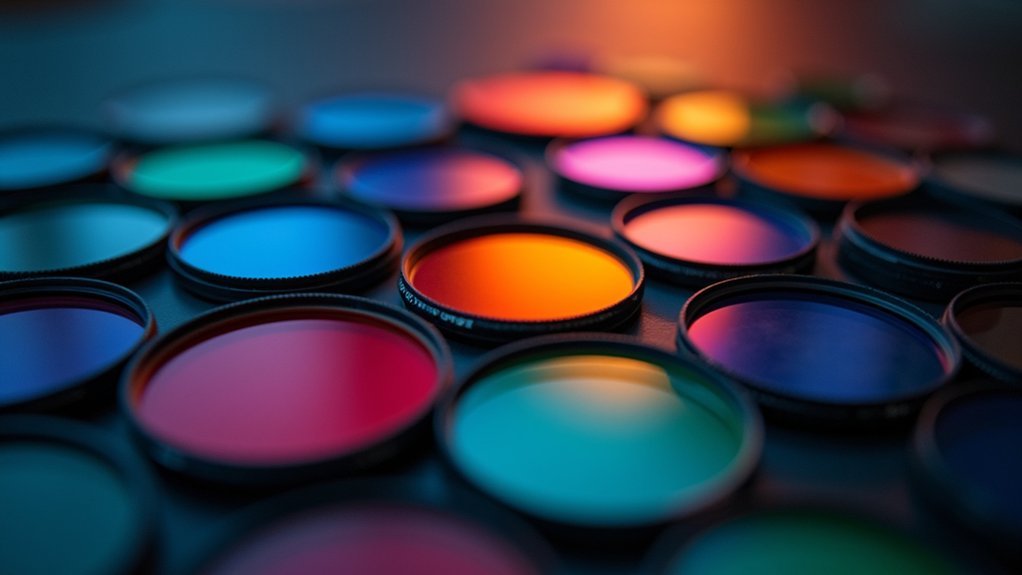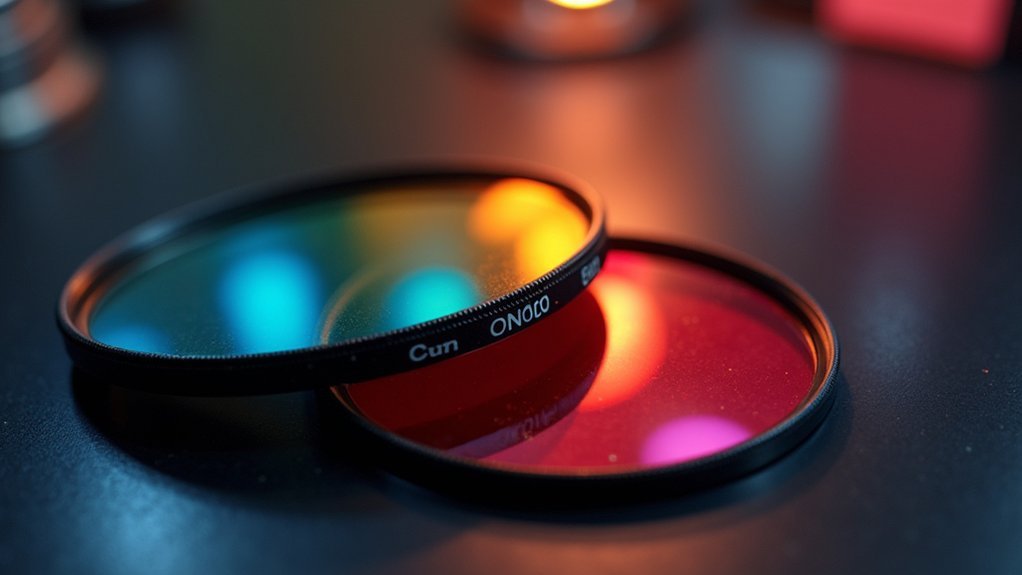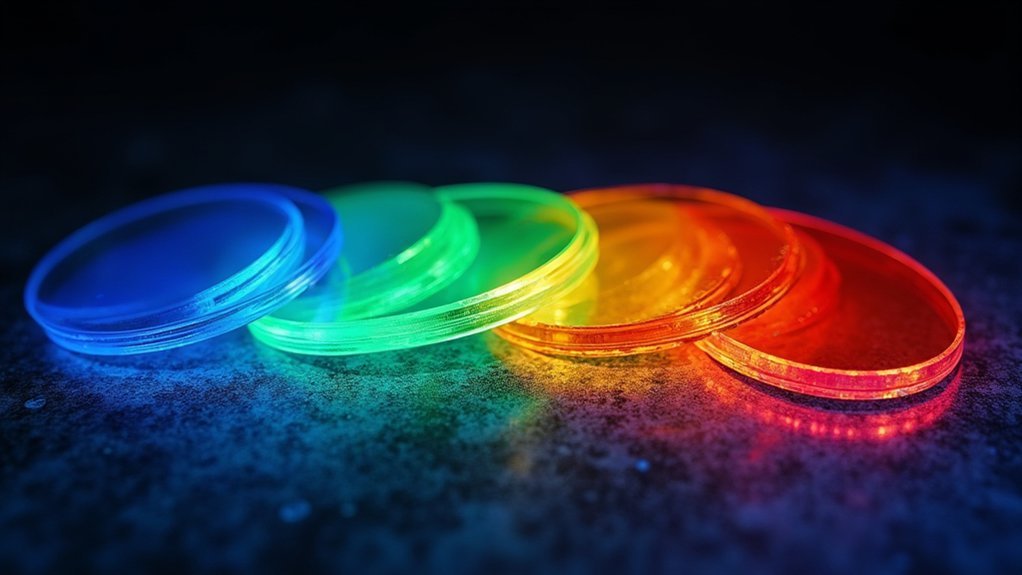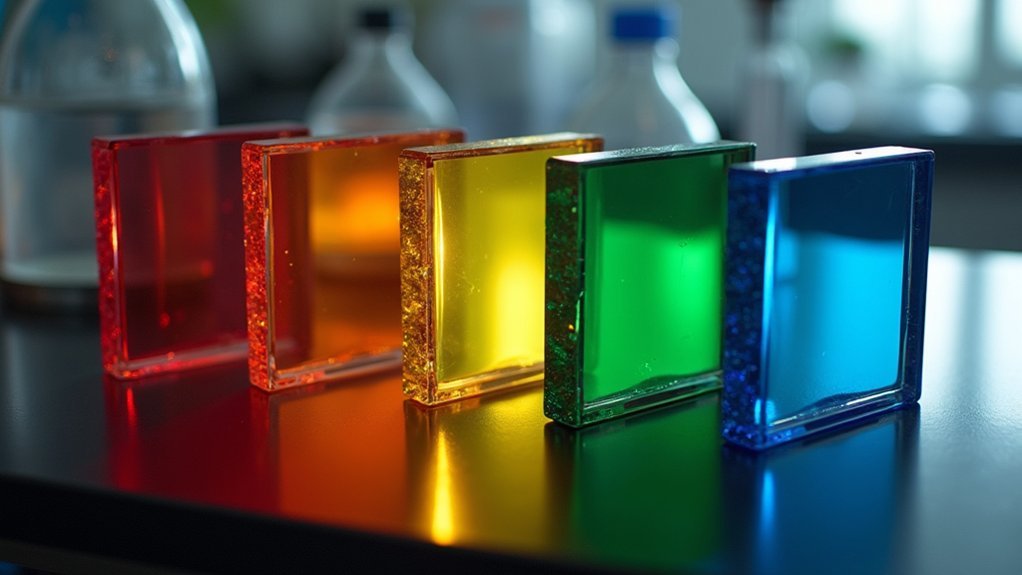The five best light filters for scientific photography include UV/IR cut filters that enhance image clarity, narrowband filters for isolating specific wavelengths, polarizing filters to eliminate glare on specimens, fluorescence filter sets for biological visualization, and B+W 420 filters for ultraviolet fluorescence work. You’ll achieve dramatically improved contrast, reduced reflections, and more accurate color reproduction in your scientific images. The right filter selection can reveal details invisible to the naked eye.
5 Best Light Filters For Scientific Photography

When capturing images for scientific purposes, selecting the right light filters can dramatically impact your results. For ultraviolet fluorescence photography, combining UV filters like the B+W 420 with an interferential UV/IR cut filter will minimize unwanted reflections and enhance image clarity.
If you’re examining artwork or identifying pigments, you’ll need a B+W 420 filter to eliminate the purple color cast from UV light. However, be aware that this filter’s own fluorescence can affect close-up image quality.
For ideal fluorescence photography, pair your UV filters with the XNite CC1 to block infrared light from UV sources. Additionally, consider using specialized barrier filters from manufacturers like NIGHTSEA to block excitation light while highlighting fluorescing materials.
Remember that narrowband filters and light pollution filters may be necessary depending on your specific scientific imaging goals and environmental conditions.
Essential UV/IR Cut Filters for Microscope Imaging
The difference between mediocre and exceptional microscope imaging often comes down to your filter selection. When conducting fluorescence photography, UV/IR cut filters are essential for eliminating unwanted light that can degrade your results.
For your camera lens in UVF microscopy, consider these specialized options:
| Filter Type | Primary Function | Best Application |
|---|---|---|
| XNite CC1 | Blocks IR from UV lamps | Ultraviolet fluorescence |
| B+W 420 | Eliminates UV light | Reduces purple dominance |
| Interferential | Minimal fluorescence emission | Close-up UVF photography |
| Custom IR Cut | Enhances color accuracy | Pigment identification |
Narrowband Filters for High-Contrast Specimen Photography

Moving beyond basic UV/IR blocking, narrowband filters represent the next level in scientific imaging precision.
These specialized filters isolate specific wavelengths of light, dramatically enhancing contrast and clarity in your specimen photography.
When you’re working with fluorescent samples, narrowband filters excel by blocking unwanted background light while allowing target emission lines like H-alpha and OIII to pass through.
You’ll capture finer details and achieve more accurate color representation in your high-contrast specimen images.
If you’re photographing in urban environments or poorly lit settings, you’ll appreciate how narrowband filters effectively combat light pollution.
By pairing these filters with appropriate light sources, you’ll reveal subtle features that might otherwise remain invisible.
This combination makes narrowband filtering invaluable for scientific analysis where detecting minute details can make the difference in your research outcomes.
Polarizing Filters for Reducing Glare in Microscopy
Glare stands as the arch-nemesis of precise microscopy imaging, obscuring critical details and compromising research results. Polarizing filters effectively combat this problem by allowing only light waves oscillating in specific directions to pass through, dramatically reducing reflections from glass slides and specimen covers.
You’ll achieve superior results by rotating your polarizing filters until they perfectly align with your light source, giving you precise control over glare reduction in your scientific photography.
| Filter Application | Benefits | Best For |
|---|---|---|
| Single polarizer | Basic glare reduction | Routine microscopy |
| Cross-polarization | Maximum contrast | Birefringent specimens |
| Variable polarization | Adjustable detail enhancement | Research photography |
When examining transparent or semi-transparent samples, these filters highlight structural differences by enhancing refractive index variations, making them essential tools for capturing high-quality microscopic images.
Fluorescence Filter Sets for Biological Sample Visualization

Fluorescence imaging represents a distinct leap beyond polarization techniques, allowing scientists to visualize biological structures that remain invisible under conventional microscopy.
When capturing these fluorescent samples, you’ll need specialized filter sets that control both excitation light and emitted fluorescence.
NIGHTSEA systems offer extensive solutions with excitation sources and barrier filters designed for specific biological applications. Common off-the-shelf options like Tiffen filters (derived from Kodak Wratten) provide consistent optical properties for fluorescence photography.
Key considerations for ideal fluorescence imaging:
- Match your excitation source with appropriate barrier filters
- Use longpass filters to capture broad emission spectra
- Choose bandpass filters for specific wavelength isolation
- Guarantee proper filtration to prevent reflected excitation light from dominating images
Selecting the right filter combination dramatically improves visualization quality, revealing biological details that would otherwise remain hidden.
Frequently Asked Questions
Do Professional Photographers Use UV Filters?
Yes, many professional photographers use UV filters to protect expensive lenses from scratches and dust. You’ll find they’re popular as a precautionary measure, though opinions vary about their impact on image quality.
Do Light Pollution Filters Actually Work?
Yes, light pollution filters do work. You’ll see significant improvements in astrophotography contrast, especially in urban areas. They selectively block artificial light wavelengths while allowing celestial object emissions to pass through.
Which Is Best UV or Skylight Filter?
UV filters are your best choice over skylight filters, especially for scientific work. They’re more effective at blocking ultraviolet radiation that causes haziness, while maintaining true colors in your photographs with greater precision.
What Is the Best Light Pollution Filter?
For astrophotography in light-polluted areas, you’ll find the Optolong L-Ultimate 3nm filter most effective. If you’re budget-conscious, consider SVBony or ZWO’s 7nm filters, which still perform well while being more affordable.
In Summary
Selecting the right light filters for your scientific photography can transform your research results. You’ll achieve clearer microscope images with UV/IR cut filters, capture precise specimen details using narrowband options, eliminate distracting glare with polarizing filters, and reveal hidden biological structures through fluorescence sets. Don’t underestimate the impact these specialized tools have on your imaging outcomes—they’re essential investments for any serious scientific photographer.





Leave a Reply